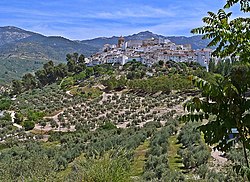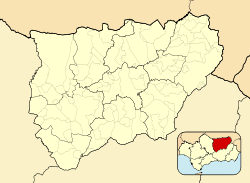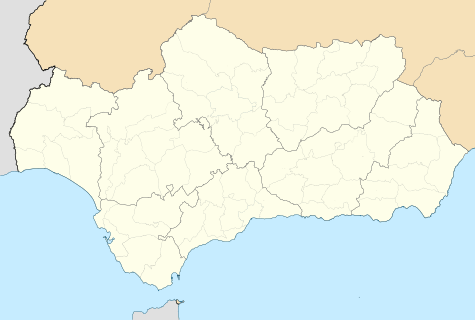Quesada, Spain
[2]Quesada is a Spanish municipality in the province of Jaén, in Andalusia. It is located in the Alto Guadalquivir region and its inhabitants are called quesadenses or quesadeños. It has an area of 328.7 km² and 5483 inhabitants according to the 2016.1 standard, although its population has gradually decreased in the last half of the twentieth century (in 1950 12,224 quesadeños were registered) .
Quesada | |
|---|---|
 | |
.svg.png) Coat of arms | |
 Quesada Location in the Province of Jaén  Quesada Location in Andalusia  Quesada Location in Spain | |
| Coordinates: 37°51′N 3°4′W | |
| Country | |
| Autonomous community | |
| Province | Jaén |
| Comarca | Sierra de Cazorla |
| Government | |
| • Mayor | Manuel Vallejo Laso (PSOE) |
| Area | |
| • Total | 328.7 km2 (126.9 sq mi) |
| Elevation | 676 m (2,218 ft) |
| Population (2018)[1] | |
| • Total | 5,303 |
| • Density | 16/km2 (42/sq mi) |
| Demonym(s) | Quesadeños |
| Time zone | UTC+1 (CET) |
| • Summer (DST) | UTC+2 (CEST) |
| Postal code | 23480 |
| Website | www |
The eastern and southern parts of its municipality are part of the Sierras de Cazorla, Segura y Las Villas Natural Park. The source of the Guadalquivir River is in its municipal district, in the Cañada de las Fuentes.[2]
Tourism
In its municipal area there are caves with rock art, although they are not visited and the remains of a Bronze Age necropolis.
There are also the ruins of the Roman Villa of Bruñel, which preserves some mosaics the most spectacular of this site dedicated to the goddess Thetis (others are exposed in the Provincial Museum of Jaén), and these can be visited, next to what you can Be a paleochristian basilica.
More recently, it is the "Watchtower of the Infant D. Enrique" of the year 1314, located at the top of the port of Tíscar and which can be visited and from whose top a wide and beautiful landscape is dominated.
Tíscar Castle, which barely retains a tower in good condition, is next to the Water Cave, a true natural monument that has an impressive waterfall inside (except during times of drought). The legend places in this cave the appearance of the Virgin of Tíscar, patron saint of Quesada, to the king of Tíscar, Mohamed Abdón, in the fourteenth century. At the foot of the castle, on a plateau, stands the sanctuary of the Virgin of Tíscar. It preserves the primitive door of the Gothic style of the 14th century. Its interior is extraordinarily beautiful, with an altar made in painted terracotta by the artists from Orea y Baños and from Neo-Romanesque style. We also find rich gates of Granada from the 17th century, as well as votive lamps from the 18th century. Keep good paintings from different eras of great masters. The verses of Antonio Machado dedicated to the Virgin of Tíscar and the Sierra de Quesada are sculpted in the sanctuary square and on a stone slab. In turn it was a tribute to the Sevillian poet that the town of Quesada honored him in 1957. From the sanctuary and in the direction of the mountains we can visit the birth of the Guadalquivir river in the heart of Quesada within its municipal term.
There is a new building on Avenida de Almería where all the paintings by Rafael Zabaleta and his friends are available. Paintings from all periods of the painter are preserved, in a chronological way, which were donated by the heirs of Zabaleta to the town of Quesada. Currently and since March 28, 2015 it houses the Miguel Hernández Museum and his wife Josefina Manresa.[2]
Economy
In agriculture the olive grove dominates, being part of its olive cooperative (La Bética Aceitera) of the designation of origin "Sierra de Cazorla".
Cereal cultivation is now vestigial, as it has been replaced by olive groves.[3]
Parties
The two most important parties are held in August and in May.
Summer parties are from August 23 to 28. On the dawn of the 29th you climb the Virgin of Tíscar from the town to the sanctuary (located 14 kilometers away). Formerly the road was done on foot, now it goes in procession to the cross of the Humilladero that is at the exit of the town, where the quesadeños and people of the region give an emotional farewell to the Mother of God and her Most Holy Son. From there the transfer continues in a vehicle.
On the other hand, on the first Saturday of May, a pilgrimage is made to bring the Virgin of Tíscar back to the town. It is known as the "brought of the Virgin" day. The Virgin crosses the town to the church where she will remain until the end of August. During the trip, the quesadeños throw loas and petals of roses and in the mantle of the virgin they pin with pins fifty or one hundred euros bills to their employer. From January 19 to 21, the festival of San Sebastián is celebrated, patron of Quesada with its typical flag bearers and drummers in addition to the lights for the most emblematic points of the town.
In the annex of Belerda the Feast of the Charges or Feast of the God Boy is celebrated, 3 a tradition that goes back to the 16th century reminiscent of the festival of Moors and Christians and that currently the clothes that carry the charges are old uniforms of the nineteenth century. The party starts on December 25. The five "Charges", first and second captain, the flag bearer, the guinche and the small charge, accompanied by the drummer and an enthusiastic entourage, depart on the 26th towards the Sanctuary of Tíscar where the image of the Virgin. During the return, from cortijada to cortijada, the tasty products of the slaughter and the good wine receive the entourage. On the 27th, with the renewal of the "Charges" of the coming year, this peculiar party ends.
Gastronomy
It is a mountain kitchen and therefore blunt. The most unique dish is the talarines, a close relative of the Gazpacho manchego and the tatters, consisting of a stew of meat, vegetables and mushrooms in which dough wafers are cooked that are broken into pieces (hence the name of tatters).
Pipirrana, crumbs, porridge, ajoharina, gachurreno, etc. are also prepared.
Some typical quesadeños sweets are: fig bread, papajotes, sweet gachillas, florets, drunkards, bath donuts.[3]
Quesada people
- Rafael Zabaleta (1907-1960), painter.
- José Luis Verdes painter, although born in Madrid, was closely related to Quesada, where he sponsored a children's painting contest. One of the local schools is named after him.
- Rafael Hidalgo de Caviedes (Quesada 1864-Madrid 1950), painter awarded several medals at the National Painting Exhibitions of the late nineteenth and early twentieth centuries.
- Josefina Manresa Marhuenda, wife of Miguel Hernández, born in Quesada on January 2, 1916 and died in Elche on February 19, 1987.
- Antonio Navarrete (Quesada, 1926-Granada, 2007), poet and writer.
- Cesáreo Rodríguez Aguilera, Magistrate, art critic, writer and senator in Cortes.
- Bienvenido Bayona Fernández (1915-2003), poet.[3]
References
- Municipal Register of Spain 2018. National Statistics Institute.
- "Quesada (Jaén)", Wikipedia, la enciclopedia libre (in Spanish), 2019-08-16, retrieved 2019-11-08
- "Quesada (Jaén)", Wikipedia, la enciclopedia libre (in Spanish), 2019-08-16, retrieved 2019-11-11